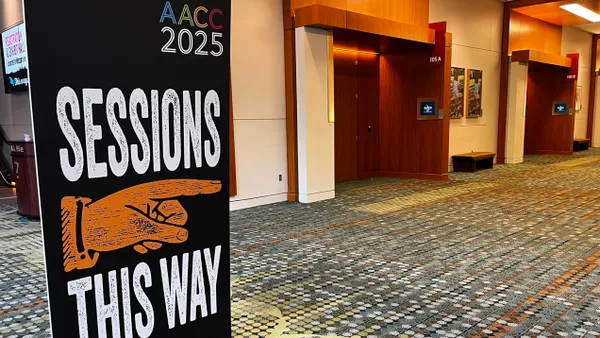Dive Brief:
- Staffing levels at college financial aid offices suffered during the pandemic, according to a new National Association of Student Financial Aid Administrators report.
- NASFAA surveyed roughly 500 of its member institutions in March and another 500 in May. The organization found in the initial survey that half of financial aid offices with at least one vacancy were operating at three-fourths of their capacity during the 2019-20 and 2020-21 academic years. Most respondents in both surveys said they experienced turnover and had to fill five or six positions during those years. Financial aid offices averaged about 10 permanent positions, although they ranged in size from just one to almost 200 permanent positions.
- More than 85% of financial aid offices reported they didn’t receive enough qualified applications for jobs. About two-thirds of respondents at those institutions said that was because poor salaries made positions uncompetitive.
Dive Insight:
Higher education has not been immune to what’s being dubbed the Great Resignation. It describes a mass exodus of workers from many industries amid the pandemic, although it is somewhat of a misnomer, as in many cases employees are jumping ship to work in better-paying jobs.
The median salary for postsecondary education positions has not kept pace with inflation, according to recent College and University Professional Association for Human Resources data. The HR group also reported a decline in the number of part-time and full-time staff.
NASFAA’s surveys attempt to capture the pandemic’s influence on employment at financial aid offices. The association found a 30% increase in the number of institutions that reported at least one vacant position in financial aid departments from the 2019-20 to 2020-21 academic years.
Full-time equivalent employees who transferred or resigned from those offices cited three major reasons for doing so. Nearly 70% said they had higher pay or better benefits in their new positions, 35% said they didn’t want to work in financial aid administration anymore, and almost 30% reported moving to a different department at the same college.
“We are sounding the alarm bells that many financial aid offices are critically short staffed, which could create cascading issues for those colleges and universities, both in their ability to adequately serve students while also remaining compliant with federal and state rules,” NASFAA President Justin Draeger said in a statement.
About 85% of institutions indicated it was difficult or very difficult to fill vacant positions with qualified individuals.
Delays in hiring also affected the process, particularly at historically underresourced institutions. More than 40% of community colleges and 45% of minority-serving institutions said their hiring processes were pushed back and that they lost candidates because of it.
About half of colleges didn’t opt to use temporary staffing. And most colleges said they don’t generally outsource. Exceptions were management of loan delinquencies and defaults, which more than 30% of colleges said was outsourced prior to March 2020, and collections, which more than 35% said was outsourced prior to that date.
The dearth of workers harmed the effectiveness of financial aid offices, according to the survey. More than half of reporting departments said they were slightly or very concerned about their ability to adequately help students, and 78% voiced concerns about being administratively capable.
“College presidents have a lot on their plate, and while they are often rushing from fire to fire, this is one area that should not be overlooked,” Draeger said.














